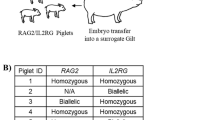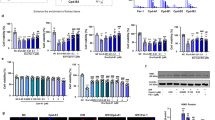Abstract
PDX1 (pancreatic and duodenal homeobox 1) is overexpressed in pancreatic cancer, and its reduction results in tumor regression. Bi-functional pbi-shRNA PDX1 nanoparticle (OFHIRNA-PDX1) utilizes the endogenous micro-RNA biogenesis pathway to effect cleavage- and non-cleavage-dependent degradation of PDX1 mRNA. We have shown that OFHIRNA-PDX1 reduces pancreatic tumor volume in xenograft models. Thus, we are now exploring biorelevant large animal safety of OFHIRNA-PDX1. Mini pigs were chosen as the biorelevant species based on the similarity of human and pig PDX1 target sequence. In the initial study, animals developed fever, lethargy, hyporexia and cutaneous hyperemia following administration of OFHIRNA-PDX1. Twenty-one days later, the same animals demonstrated less toxicity with a second OFHIRNA-PDX1 infusion in conjunction with a prophylactic regimen involving dexamethasone, diphenhydramine, Indocin and ranitidine. In a new group of animals, PDX1 protein (31 kDa) expression in the pancreas was significantly repressed at 48 and 72 h (85%, P=0.018 and 88%, P=0.013; respectively) following a single infusion of OFHIRNA-PDX1 but recovered to normal state within 7 days. In conclusion, a single intravenous infusion of OFHIRNA-PDX1 in conjunction with premedication in pigs was well tolerated and demonstrated significant PDX1 knockdown.
This is a preview of subscription content, access via your institution
Access options
Subscribe to this journal
Receive 12 print issues and online access
$259.00 per year
only $21.58 per issue
Buy this article
- Purchase on Springer Link
- Instant access to full article PDF
Prices may be subject to local taxes which are calculated during checkout









Similar content being viewed by others
References
Hariharan D, Saied A, Kocher HM . Analysis of mortality rates for pancreatic cancer across the world. HPB (Oxford) 2008; 10: 58–62.
Ferlay J, Shin HR, Bray F, Forman D, Mathers C, Parkin DM . Estimates of worldwide burden of cancer in 2008: GLOBOCAN 2008. Int J Cancer 2010; 127: 2893–2917.
Ferlay J, Shin HR, Bray F, Forman D, Mathers C, Parkin DM . GLOBOCAN 2008 v1.2, Cancer Incidence and Mortality Worldwide: IARC CancerBase No. 10 [Internet]. International Agency for Research on Cancer: Lyon, France, 2010 Available from http://globocan.iarc.fr [cited May 2011].
American Cancer Society Cancer Facts and Figures 2010. American Cancer Society: Atlanta, GA, USA, 2010.
Benson AB, Myerson RJ, Sasson AR . Pancreatic, neuroendocrine GI, and adrenal cancers. Cancer Management: A Multidisciplinary Approach 13th edn. UBM Medica LLC: New York, 2010.
Koizumi M, Doi R, Toyoda E, Masui T, Tulachan SS, Kawaguchi Y et al. Increased PDX-1 expression is associated with outcome in patients with pancreatic cancer. Surgery 2003; 134: 260–266.
Liu T, Gou SM, Wang CY, Wu HS, Xiong JX, Zhou F . Pancreas duodenal homeobox-1 expression and significance in pancreatic cancer. World J Gastroenterol 2007; 13: 2615–2618.
Wang XP, Li ZJ, Magnusson J, Brunicardi FC . Tissue microarray analyses of pancreatic duodenal homeobox-1 in human cancers. World J Surg 2005; 29: 334–338.
Offield MF, Jetton TL, Labosky PA, Ray M, Stein RW, Magnuson MA et al. PDX-1 is required for pancreatic outgrowth and differentiation of the rostral duodenum. Development 1996; 122: 983–995.
Hui H, Perfetti R . Pancreas duodenum homeobox-1 regulates pancreas development during embryogenesis and islet cell function in adulthood. Eur J Endocrinol 2002; 146: 129–141.
McKinnon CM, Docherty K . Pancreatic duodenal homeobox-1, PDX-1, a major regulator of beta cell identity and function. Diabetologia 2001; 44: 1203–1214.
Gannon M, Ables ET, Crawford L, Lowe D, Offield MF, Magnuson MA et al. pdx-1 function is specifically required in embryonic beta cells to generate appropriate numbers of endocrine cell types and maintain glucose homeostasis. Dev Biol 2008; 314: 406–417.
Li Y, Zhang R, Qiao H, Zhang H, Wang Y, Yuan H et al. Generation of insulin-producing cells from PDX-1 gene-modified human mesenchymal stem cells. J Cell Physiol 2007; 211: 36–44.
Koizumi M, Doi R, Fujimoto K, Ito D, Toyoda E, Mori T et al. Pancreatic epithelial cells can be converted into insulin-producing cells by GLP-1 in conjunction with virus-mediated gene transfer of pdx-1. Surgery 2005; 138: 125–133.
Wang X, Zhou J, Doyle ME, Egan JM . Glucagon-like peptide-1 causes pancreatic duodenal homeobox-1 protein translocation from the cytoplasm to the nucleus of pancreatic beta-cells by a cyclic adenosine monophosphate/protein kinase A-dependent mechanism. Endocrinology 2001; 142: 1820–1827.
Aviv V, Meivar-Levy I, Rachmut IH, Rubinek T, Mor E, Ferber S . Exendin-4 promotes liver cell proliferation and enhances the PDX-1-induced liver to pancreas transdifferentiation process. J Biol Chem 2009; 284: 33509–33520.
Zhou J, Pineyro MA, Wang X, Doyle ME, Egan JM . Exendin-4 differentiation of a human pancreatic duct cell line into endocrine cells: involvement of PDX-1 and HNF3beta transcription factors. J Cell Physiol 2002; 192: 304–314.
Liu S, Ballian N, Belaguli NS, Patel S, Li M, Templeton NS et al. PDX-1 acts as a potential molecular target for treatment of human pancreatic cancer. Pancreas 2008; 37: 210–220.
Liu SH, Rao DD, Nemunaitis J, Senzer N, Zhou G, Dawson D et al. PDX-1 is a therapeutic target for pancreatic cancer, insulinoma and islet neoplasia using a novel RNA interference platform. PLoS One 2012; 7: e40452.
Rao DD, Maples PB, Senzer N, Kumar P, Wang Z, Pappen BO et al. Enhanced target gene knockdown by a bifunctional shRNA: a novel approach of RNA interference. Cancer Gene Ther 2010; 17: 780–791.
Templeton NS, Lasic DD, Frederik PM, Strey HH, Roberts DD, Pavlakis GN . Improved DNA: liposome complexes for increased systemic delivery and gene expression. Nat Biotechnol 1997; 15: 647–652.
Bode G, Clausing P, Gervais F, Loegsted J, Luft J, Nogues V et al. The utility of the minipig as an animal model in regulatory toxicology. 2010 J Pharmacol Toxicol Methods 62: 196–220.
Swindle MM, Smith AC, Laber KL, Goodrich JA, Bingel SA . Biology and Medicine of Swine. International Veterinary Information Service: Ithaca, NY, USA, 2003.
Senzer N, Nemunaitis J, Nemunaitis D, Bedell C, Edelman G, Barve M et al. Phase I study of a systemically delivered p53 nanoparticle in advanced solid tumors. Mol Ther 2013; 21: 1096–1103.
Penninks AH, van Mierlo GJ . Immunotoxicity studies in minipigs. In: McAnulty PA, Dayan AD, Ganderup NC, Hastings KL (eds). The Minipig in Biomedical Research. CRC Press/Taylor and Francis: New York, NY, USA, 2012: 397–411.
Lu C, Stewart DJ, Lee JJ, Ji L, Ramesh R, Jayachandran G et al. Phase I clinical trial of systemically administered TUSC2(FUS1)-nanoparticles mediating functional gene transfer in humans. PLoS One 2012; 7: e34833.
Jay C, Nemunaitis G, Nemunaitis J, Senzer N, Hinderlich S, Darvish D et al. Preclinical assessment of wt GNE gene plasmid for management of hereditary inclusion body myopathy 2 (HIBM2). Gene Regul Syst Bio 2008; 2: 243–252.
Eager RM, Nemunaitis J . Clinical development directions in oncolytic viral therapy. Cancer Gene Ther 2011; 18: 305–317.
Macfarlane WM, McKinnon CM, Felton-Edkins ZA, Cragg H, James RF, Docherty K . Glucose stimulates translocation of the homeodomain transcription factor PDX1 from the cytoplasm to the nucleus in pancreatic beta-cells. J Biol Chem 1999; 274: 1011–1016.
Kishi A, Nakamura T, Nishio Y, Maegawa H, Kashiwagi A . Sumoylation of Pdx1 is associated with its nuclear localization and insulin gene activation. Am J Physiol Endocrinol Metab 2003; 284: E830–E840.
Berezhna SY, Supekova L, Supek F, Schultz PG, Deniz AA . siRNA in human cells selectively localizes to target RNA sites. Proc Natl Acad Sci USA 2006; 103: 7682–7687.
Carlotti F, Zaldumbide A, Charif H, de Koning EJ, Luider TM, Hoeben RC . The 45-kDa form of Pdx-1 does not result from post-translational modifications. Biochem Biophys Res Commun 2008; 370: 225–229.
Liu SH, Patel S, Gingras MC, Nemunaitis J, Zhou G, Chen C et al. PDX-1: demonstration of oncogenic properties in pancreatic cancer. Cancer 2011; 117: 723–733.
Acknowledgements
We gratefully acknowledge Bill and Olivia Heintz for their support and advice in the development of this project.
Author information
Authors and Affiliations
Corresponding author
Ethics declarations
Competing interests
CJ, PK, DR, CE, ZW, FCB, NS, JN and PM are shareholders in Gradalis, Inc. All the other authors declare no conflict of interest.
Rights and permissions
About this article
Cite this article
Jay, C., Ruoff, C., Kumar, P. et al. Assessment of intravenous pbi-shRNA PDX1 nanoparticle (OFHIRNA-PDX1) in yucatan swine. Cancer Gene Ther 20, 683–689 (2013). https://doi.org/10.1038/cgt.2013.68
Received:
Accepted:
Published:
Issue Date:
DOI: https://doi.org/10.1038/cgt.2013.68



